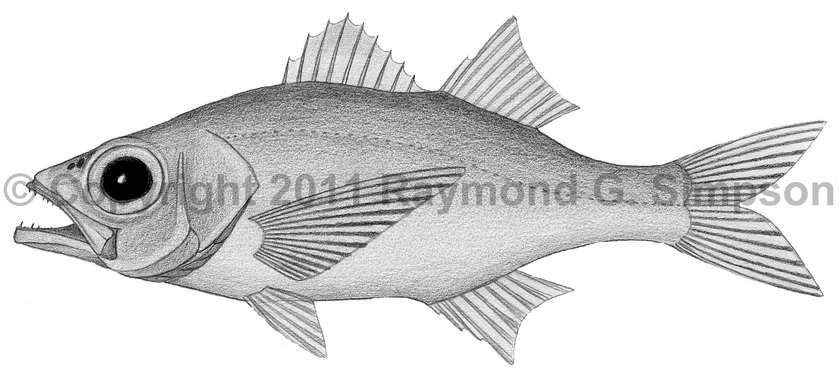
Common Name
Black Lanternbelly
Year Described
Poey, 1860
Identification
Dorsal Fin: IX; I,9-10
Anal Fin: III, 7
Pectoral Fin: 15
Pelvic Fin: I, 5
Lateral Line Scales: 43-45
Gill Rakers: 23-26 total in first arch (14-16 in lower limb)
Body fairly deep with body depth 2.9-3.4 times in SL. Lower and upper jaw symphyses with a large canine on either side. Mid-lateral side of lower jaw with 12-14 small canine teeth. Rest of jaw with villiform teeth. Basioccipital fossa absent. Preopercle weak and without serrations. Dorsal fins close together. Anterior margins of fin spines smooth. First anal fin pterygiophore straight, tapered, and pointed at the antero-dorsal end. Body with ctenoid scales anteriorly and cycloid scales posteriorly (gradation around base of first dorsal fin) (Yamanoue et al., 2009).
Color
Dark gray above, grading to silvery or whitish below. Dorsal and caudal fin dark. Anal and pelvic fins dark with pale posterior margins.
Size
Adults from 186-295mm SL.
Habitat
Continental shelf from 100-600m.
Range
Scattered records in the Caribbean: Cuba, Puerto Rico, Belize, Honduras, Colombia, and Venezuela. Also off Brazil (Carvalho-Filho et al., 2010). Probably fairly widespread in deeper waters.
References
Carvalho-Filho, A. , G. Marcovaldi, C.L.S. Sampaio, M.I.G. Paiva and L.A.G. Duarte. 2010. Two new records of uncommon deep-sea perciform fishes from the southwestern Atlantic. Zootaxa No. 2694: 59-68.
Heemstra, P.C. 2002. Parazenidae (Pp. 1203-1204), Zeniontidae (Pp. 1205-1206), Zeidae (Pp. 1207-1209), Oreosomatidae (Pp. 1212-1213), Grammicolepidae (Pp. 1214-1216), Moronidae (Pp. 1294-1296), Acropomatidae (Pp. 1299-1303). In: Carpenter, 2002. The living marine resources of the Western Central Atlantic Vol. 2: Bony fishes part 1 (Acipenseridae to Grammatidae). FAO Species Identification Guides for Fisheries Purposes. American Society of Ichthyologists and Herpetologists Special Publication No. 5.
Yamanoue, Y. , G.D. Johnson, and W.C. Starnes. 2009. Redescription of a poorly known acropomatid, Verilus sordidus Poey 1860, and comparison with Neoscombrops atlanticus Mochizuki and Sano 1984 (Teleostei: Perciformes). Ichthyological Research v. 56 (no. 4): 400-406.